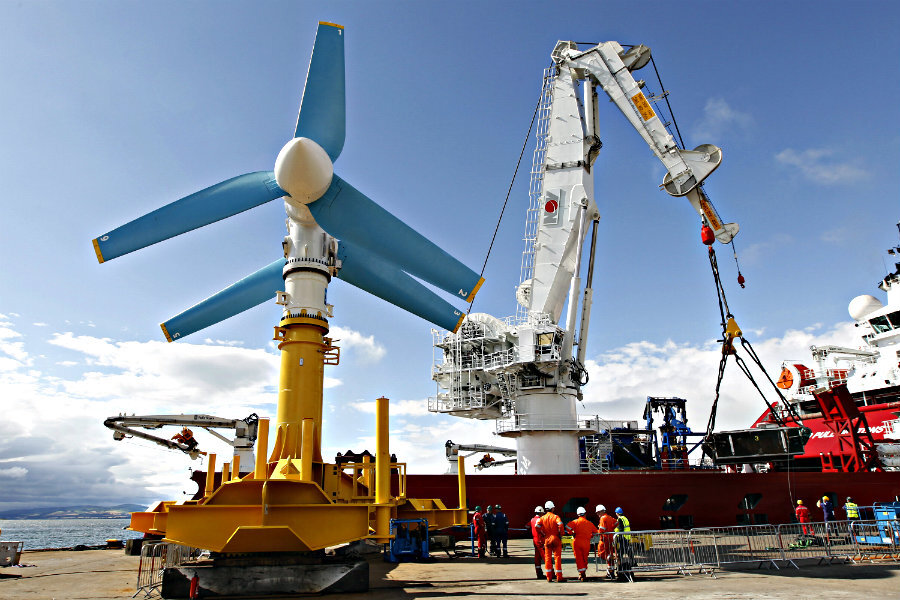How the tides could fuel a greener future
Loading...
On Monday, energy company Nova Innovation announced that it has become the first to construct an offshore tidal plant to deliver energy to the grid via an array of turbines.
Nova Innovations has now installed two turbines in an array off the coast of Shetland, where it hopes to harvest renewable energy from the rising and falling of the tides. Experts say that, while hydrokinetic energy sources such as wave and tidal energy are relatively unknown, they could play a major role in the future of renewable energy.
“The future of energy worldwide will be renewable energy,” says Jason Busch, president of Oregon Wave Energy Trust in Portland, Ore., in a phone interview with The Christian Science Monitor. “The oceans are an enormous resource that are almost entirely untapped.”
[Editor’s note: The original version of this story incorrectly attributed this quote to former OWET president Chris Taylor.]
There are several types of marine energy that researchers and energy companies are working to explore – two of the best known are wave energy and tidal energy.
Wave energy, as the name suggests, captures energy using the motion of ocean waves. One advantage of using the waves to capture power, according to Mr. Busch, is that the equipment can be placed far out at sea. For tidal energy’s part, proponents say that the underwater turbines capture energy on a highly predictable schedule – the unerring rhythm of the tides.
There are several organizations working to test and highlight the benefits of marine renewable energy, although Scotland is the indisputable leader in the field, and is working primarily with tidal energy.
While marine energy projects are still in the process of gaining recognition worldwide, Britain has long been a leader in the area. Tides are stronger in geographic regions that are closer to either of the poles, a phenomenon that has catapulted Scotland to the top of the marine energy food chain.
“Scotland is already leading the way for tidal energy,” says George Hagerman, a senior research associate at Virgina Tech who specializes in marine renewable energy systems. “Scotland has tremendous resources.”
In fact, a small portion of Britain’s seacoast, including northern Scotland and the Orkney Islands, represents 50 percent of Britain’s tidal resources, and 25 percent of Europe’s, according to the Scottish government.
While Mr. Hagerman tells the Monitor that early hydroelectric projects (such as forming dams at the mouths of natural bays) were largely rejected because of the impact they would have had on natural tidal processes, the idea of harnessing the tides themselves has been gaining traction. Damming bays would have completely cut off the ebb and flow of the tides, whereas harnessing tidal energy through turbines does not disrupt the natural flow of water, and therefore has less of an impact on the ecosystem.
One major benefit of tidal energy, experts say, is that it is extremely predictable. Energy experts are never quite sure how strong or frequent winds will be, nor exactly what percentage of a year’s days will be sunny. Yet because tides are driven by the interactions between the Earth, the moon, and the sun, according to Hagerman, scientists are sure of precisely when they will occur.
Researchers also say that tidal energy has the potential to be less environmentally damaging because water is more viscous. Unlike wind turbines, for example, tidal turbines are less likely to kill passing wildlife.
“All the reports say that there is no known adverse impact from our power systems,” says Chris Sauer, the president and chief executive officer of Maine’s Ocean Renewable Power Company, a leading US developer of renewable marine energy technology.
Still, things aren’t all rosy for marine energy sources.
“I think tidal has great potential, but there are challenges. We are probably still five or more years away from much commercial development and longer for tidal to reach its real potential,” hydrokinetic energy development expert Andrea Copping writes by email. “In the US, the Department of Energy has been investing heavily in both tidal technologies and also understanding the potential risks to help smooth the way for siting and permitting.”
Dr. Copping also tells the Monitor that it is difficult to say whether turbines will adversely impact the environment, as they are still relatively new and uncommon.
Some of the challenges involved in implementing tidal energy turbines, such as the ones installed this week on the Shetland coast, are the practical difficulties of fundraising capital for technology that is still relatively unproven.
Some fishermen also complain that the placement of tidal turbines could restrict their anchoring or dragging (for scallops, for example) activities. Experts say, however, that most shipping should not be affected, and that the swift currents that make some geographic areas ideal for turbine placement also make them a poor place to fish.
According to a 2010 article in Scientific American, five percent of the United State’s households could be lighted using tidal energy in the future. Mr. Sauer also tells the Monitor that there is great potential for tidal energy technology to reach many of the world’s 700 million people who rely solely on diesel fuels, which release pollution into the atmosphere.
Researchers agree, however, that tidal energy will never be the whole solution. Instead, it is likely to form a part of the renewable energy portrait, alongside other technologies like wind or solar power.
“The future of energy in America is not going to be one thing or another,” says Sauer. “It will be a combination of a number of renewable technologies.”








